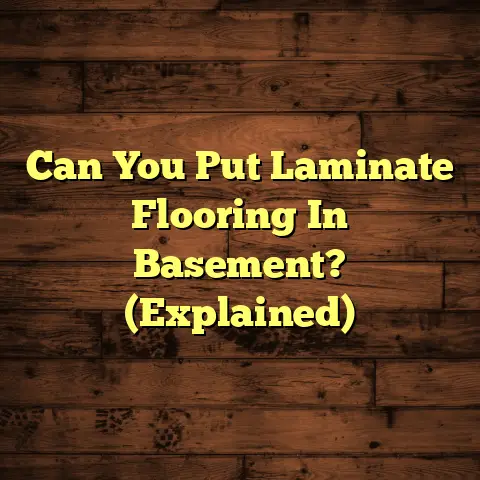Black & Grey Tile Patterns? (5 Trend Setters!)
I’m excited to dive into the world of black and grey tile patterns.
As a flooring contractor, I’ve seen trends come and go, but black and grey?
These are timeless.
They’re like the little black dress of interior design.
Ready to explore five trendsetters that are revolutionizing spaces?
Let’s get started!
1. The Allure of Black and Grey Tiles
1.1 The Psychological Impact of Colors
Ever wonder why black and grey are so popular?
It’s not just about looks.
Colors have a real impact on how we feel.
Black often represents sophistication, power, and elegance.
Think of a sleek black car or a classic black suit.
Grey, on the other hand, evokes feelings of calm, balance, and neutrality.
It’s the perfect backdrop for pops of color.
Together, they create a sense of modern sophistication that’s hard to resist.
1.2 Historical Context
Tiles have been around for centuries, from ancient Roman mosaics to Victorian-era geometric designs.
But black and grey tiles?
They’ve seen a major resurgence lately.
I’ve noticed more and more clients asking for them.
Why?
Because they’re versatile and fit seamlessly into contemporary designs.
They offer a nod to the past while feeling fresh and modern.
1.3 Versatility in Design
One of the best things about black and grey tiles is their versatility.
They can rock a minimalist vibe, complement an industrial aesthetic, or add a touch of elegance to a classic space.
I’ve installed them in everything from modern lofts to traditional homes.
They always seem to fit right in.
Whether you’re aiming for a sleek, modern look or a cozy, traditional feel, these tiles can adapt.
2. Trendsetter #1 – Geometric Patterns
2.1 Description and Characteristics
Geometric tile patterns are all about shapes: hexagons, triangles, chevrons, you name it.
They add visual interest and can create a dynamic focal point in any room.
I’ve found that the key is to choose shapes that complement the space’s overall design.
For example, hexagons can give a modern, honeycomb feel, while chevrons add a sense of movement and energy.
2.2 Design Applications
Where can you use geometric patterns?
Everywhere!
Kitchens, bathrooms, living rooms – the possibilities are endless.
I recently installed a black and grey geometric tile backsplash in a kitchen.
It instantly transformed the space from drab to fab.
In bathrooms, geometric patterns can add a touch of modern elegance.
Living rooms benefit from the visual interest they bring to floors or feature walls.
2.3 Influential Designers
So many designers are embracing geometric tiles.
Kelly Wearstler, for example, is known for her bold use of geometric patterns.
She often incorporates them into her designs to create a sense of playfulness and sophistication.
I always look to designers like her for inspiration when working with clients.
Their innovative use of geometric tiles can spark some fantastic ideas.
3. Trendsetter #2 – Herringbone and Chevron Patterns
3.1 Description and Characteristics
Herringbone and chevron patterns are classic for a reason.
They’re elegant, timeless, and add a touch of sophistication to any space.
But what’s the difference?
Herringbone patterns feature rectangular tiles arranged in a staggered, zig-zag pattern.
Chevron patterns have tiles cut at an angle to create a continuous V-shape.
Both create movement and visual interest, but chevron patterns tend to be more dynamic.
3.2 Design Applications
These patterns are perfect for creating focal points or adding depth to a room.
I once used a black and grey herringbone pattern on a bathroom floor.
It instantly elevated the space, making it feel more luxurious and inviting.
Chevron patterns can be used to create a striking feature wall in a living room.
They draw the eye and add a sense of drama.
3.3 Cultural Significance
Herringbone and chevron patterns have a rich history.
They’ve been used in various cultures for centuries, from ancient Roman roads to medieval textiles.
Today, they’re reinterpreted in modern designs, offering a nod to the past while feeling completely contemporary.
I love how these patterns can bridge the gap between traditional and modern aesthetics.
4. Trendsetter #3 – Monochromatic Mosaics
4.1 Description and Characteristics
Monochromatic mosaics use varying shades of black and grey to create depth and visual interest.
They’re subtle yet impactful.
Think of it as creating a gradient effect with tiny tiles.
This technique can add a sense of texture and dimension to a flat surface.
4.2 Design Applications
Monochromatic mosaics work well in both small and large spaces.
In smaller areas, they can create the illusion of depth.
In larger spaces, they add a sophisticated, understated elegance.
I’ve seen some stunning artistic installations using monochromatic mosaics.
They can transform an ordinary wall into a work of art.
4.3 Artistic Inspirations
Artists like M.C. Escher, known for his intricate geometric designs, have inspired the use of monochromatic mosaics.
His work often plays with perspective and dimension, which can be translated into tile designs.
I find that looking to art for inspiration can lead to some truly unique and innovative tile installations.
5. Trendsetter #4 – Textured Tiles
5.1 Description and Characteristics
Texture is key in tile design, especially with black and grey tiles.
Different textures can affect how light interacts with the surface, creating unique visual effects.
Matte finishes offer a soft, understated look, while glossy finishes reflect light and add a touch of glamour.
3D textures can create depth and tactile interest.
5.2 Design Applications
Textured tiles can be used to create tactile experiences in various environments.
I once installed textured black tiles in a spa-like bathroom.
The texture added a sense of warmth and comfort, making the space feel more inviting.
In commercial spaces, textured tiles can add visual interest and help to define different areas.
5.3 Trends in Sustainability
Sustainable tile production is becoming increasingly important.
Many manufacturers are now using recycled materials and eco-friendly processes to create textured tiles.
I always try to recommend sustainable options to my clients.
It’s a great way to reduce our environmental impact while still achieving a beautiful design.
6. Trendsetter #5 – Bold Borders and Accents
6.1 Description and Characteristics
Using black and grey tiles as borders or accents is a fantastic way to frame spaces or highlight architectural features.
Think of it as adding a picture frame to a room.
These elements can define the boundaries of a space and draw attention to specific areas.
6.2 Design Applications
Practical applications include framing a fireplace, highlighting a doorway, or creating a border around a room.
I recently used black tiles to frame a white fireplace.
It instantly became the focal point of the room.
Accents can also be used to break up large areas of plain tiles, adding visual interest and depth.
6.3 The Role of Contrast
Contrast is key when using borders and accents.
Pairing black tiles with white walls, or vice versa, can create a striking visual effect.
The contrast enhances the overall aesthetic and adds a sense of drama.
It’s all about creating balance and harmony in the space.
Conclusion
So, there you have it!
Five trendsetting black and grey tile patterns that are revolutionizing interior design.
From geometric designs to monochromatic mosaics, these patterns offer endless possibilities for creating stylish and sophisticated spaces.
Black and grey tiles are versatile, elegant, and timeless.
I encourage you to consider how you might integrate these patterns into your own home or commercial space.
Tile design is constantly evolving, so embrace the possibilities and get creative!
I’m always excited to see how people use these trends to create unique and personalized spaces.
Happy tiling!





